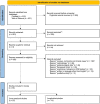Investigating the borders of autism spectrum disorder: lessons from the former diagnosis of pervasive developmental disorder not otherwise specified
- PMID: 38173703
- PMCID: PMC10762794
- DOI: 10.3389/fpsyt.2023.1149580
Investigating the borders of autism spectrum disorder: lessons from the former diagnosis of pervasive developmental disorder not otherwise specified
Abstract
Introduction: Autism Spectrum Disorder (ASD) diagnosis is relatively consensual in typical forms. The margins of the spectrum and their degree of extension, however, are controversial. This has far-reaching implications, which extend beyond theoretical considerations: first, peripheral forms of autism are more prevalent than central forms; second, we do not know how relevant typical-targeted recommendations are for atypical forms. In DSM-IV-TR, these margins of autism were studied within the category of Pervasive Developmental Disorder - Not Otherwise Specified (PDD-NOS). In spite of its low reliability, this former diagnosis was of particular interest to shed light on the gray area of margins. The aim of this systematic is therefore to investigate the clinical characteristics of PDD-NOS in comparison with Autistic Disorder.
Method: A stepwise systematic PRISMA literature review was conducted by searching PubMed and Web Of Science databases to select corresponding studies.
Results: The systematic review included 81 studies comprising 6,644 children with PDD-NOS. Cross-sectional and longitudinal studies comparing PDD-NOS and AD showed that PDD-NOS corresponds to milder form of autism with less impact and less associated disorder, with the exception of schizophrenia and mood disorder.
Discussion: Our review challenges initial views of PDD-NOS, and shows the clinical relevance of this diagnosis when dealing with the margins of autism, and the de facto diversity included in the spectrum. However, in view of the many limitations of PDD-NOS (low reliability, instability through time, low acceptability), we suggest taxonomic changes in DSM-5: we introduce a new category based on three main dimensions related to socialization impairment, emotional lability and psychotic symptoms.
Conclusion: Our review argues for a distinction between AD and PDD-NOS on clinical characteristics and thus highlights the need to study the margins of autism. While the limitations of the PDD-NOS category made it irrelevant to investigate these margins from a research perspective, we believe that a multidimensional approach for mental health professionals taping socialization, emotion lability and psychotic symptoms would be interesting. Our review therefore encourage future studies to test relevant criteria for a new category and possibly identify developmental trajectories, specific interventions and treatments.
Keywords: DSM-5; DSM-IV-TR; autism spectrum disorder; diversity; heterogeneity; pathological demand avoidance; pervasive developmental disorder.
Copyright © 2023 Coutelle, Coulon, Schröder and Putois.
Conflict of interest statement
The authors declare that the research was conducted in the absence of any commercial or financial relationships that could be construed as a potential conflict of interest.
References
-
- American Psychiatric Association . DSM-5: Diagnostic and statistical manual of mental disorders. fifth ed. Washington, DC: American Psychiatric Association; (2013).
-
- Vaan G, Vervloed M, Knoors H, Verhoeven L. “Autism Spectrum disorders in people with sensory and intellectual disabilities–symptom overlap and differentiating characteristics.” Intech. (2013). p. 477–498.
-
- Félix J, Santos ME, Benitez-Burraco A. Specific language impairment, autism Spectrum disorders and social (pragmatic) communication disorders: is there overlap in language deficits? A review. Rev J Autism Dev Disord. (2022) 4:1–21. doi: 10.1007/s40489-022-00327-5 - DOI
Publication types
LinkOut - more resources
Full Text Sources


